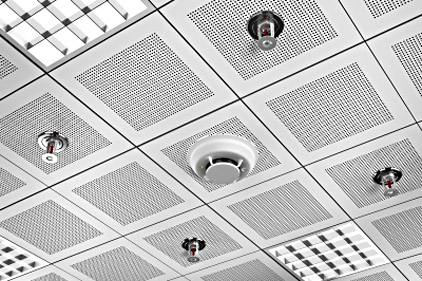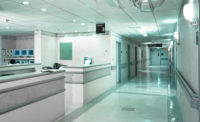
Figure 1. Plenum arrangement with diffuser or return air grille
located in an egress corridor and adjoining areas.
Incorporating a plenum can have its design advantages, but corridors serving adjoining areas of health care occupancies are prohibited from being used for a portion of an air supply, air return, or exhaust air plenum. This article and its illustrations can strengthen your grasp of the related NFPA code details and exceptions so you can design and ventilate properly for this special population.
In the built environment, a plenum is a separate space specifically for air circulation for HVAC, typically provided in the space between the structural floor/ceiling and a suspended-grid acoustical tile ceiling. When making design decisions, you should consider the advantages and disadvantages of plenum configurations.
ADVANTAGES
Return plenums reduce energy usage.- Return plenums significantly reduce installed mechanical costs due to the elimination of all return air ductwork, reduced fan motor and VFD hp, and reduced relief system costs (non-powered relief and relief fans are less expensive than return fans).
- Return plenums are essentially self-balancing and thus obviate the need for balancing labor.
- Return plenums typically reduce the required depth of the ceiling space, and shafts can be smaller because the entire free area of the shaft and ceiling are available for return airflow.
- Return plenums greatly reduce ceiling coordination among trades by eliminating the large return air ducts and the need to cross over supply and return mains to serve zones.
DISADVANTAGES
Using building cavities as return air plenums can draw them below atmospheric pressure if not properly designed, causing outdoor air to be drawn into the building fabric. In humid climates, this can result in condensation of moisture from outdoor air within architectural cavities, consequently resulting in mold and mildew growth.- Most building codes only allow architectural cavities to be used as air
plenums if the materials exposed to the plenum meet certain flame spread and
smoke generation limits. This means that ceiling plenums that are exposed to
wood joists or plywood decks usually cannot be used as return air plenums.
- Wiring (electric, control, and telecommunication) must be plenum-rated.
- Individual space pressurization control is not possible, which is a critical
issue in laboratories and health care buildings.
- Care must be taken at full height walls to be sure that adequate openings are
provided for return air transfer and that the openings are acoustically treated
where necessary (e.g., with lined elbows or boots).
- Some IAQ experts have concerns that return air plenums can lead to IAQ problems due to the debris and dust that can accumulate on ceiling tiles, etc.

Figure 2. Plenum arrangement with diffuser or return air grille
located in an egress corridor and ducted HVAC.
APPLICABLE CODES AND STANDARDS
Applicable codes and standards vary from jurisdiction to jurisdiction. It is essential that mechanical designers and contractors identify the applicable codes and standards and their editions. Health care organizations that receive Medicare and Medicaid funding from The Center for Medical Services (CMS) must comply with the 2000 edition of NFPA 101®, Life Safety Code®, Chapter 18, “New Health Care Occupancies.” Chapter 19, “Existing Health Care Occupancies,” under the Building Services section, states, “Heating, ventilating, and air conditioning shall comply with the provisions of Section 9.2 and shall be installed in accordance with the manufacturer’s specifications.”Section 9.2 states “Air conditioning, heating, ventilating ductwork, and related equipment shall be in accordance with NFPA 90A, Standard for the Installation of Air-Conditioning and Ventilating Systems, or NFPA 90B, Standard for the Installation of Warm Air Heating and Air-Conditioning Systems, as applicable, unless existing installations, which shall be permitted to be continued in service, subject to approval by the authority having jurisdiction.”

Figure 3. Plenum arrangement with diffuser or return air grille
located in an egress corridor and ducted HVAC, not serving adjoining areas.
Note: The Joint Commission interprets the NFPA code to allow incidental air movement between rooms and corridors (such as isolation rooms) because of the need for pressure differentials in health care facilities. In such cases, the direction of airflow is not the focus for this element of performance. For the purpose of fire protection, air transfer should be limited to the amount necessary to maintain positive or negative pressure differentials. (For full text and any exceptions, refer to NFPA 90A-1999: 2-3.11.1)
NFPA 90A, Standard for the Installation of Air-Conditioning and Ventilating Systems, 1999 Edition
- 2-3.11 Corridor Air Systems.
- 2-3.11.1* Egress Corridors.
Egress corridors in health care, detention and correctional, and residential occupancies shall not be used as a portion of a supply, return, or exhaust air system serving adjoining areas. An air transfer opening(s) shall not be permitted in walls or in doors separating egress corridors from adjoining areas.
- Exception No. 1: Toilet rooms, bathrooms, shower rooms, sink closets, and
similar auxiliary spaces opening directly onto the egress corridor.
- Exception No. 2: Where door clearances do not exceed those specified for fire
doors in NFPA 80, Standard for Fire Doors and Fire Windows, air transfer caused
by pressure differentials shall be permitted.
- Exception No. 3: Use of egress corridors as part of an engineered
smoke-control system.
- Exception No. 4: In detention and correctional occupancies with corridor separations of open construction (e.g., grating doors or grating partitions).
Figure 2 illustrates a plenum arrangement with a diffuser or return air grille located in the egress corridor and ducted HVAC for the adjoining areas such as patient rooms. Under this arrangement, the above-mentioned provisions would be acceptable in health care occupancies because the plenum would not be serving adjoining areas. The ducted supply to the corridor is not shown. With a fire that originates in the egress corridor, smoke and products of combustion accumulating in the plenum would not be able to enter the patient rooms.
Figure 3 illustrates a plenum arrangement with a diffuser or return air grille located in the egress corridor and ducted HVAC for the adjoining areas such as patient rooms. Under this arrangement, the above-mentioned provisions would be acceptable in health care occupancies because the plenum would not be serving adjoining areas. The ducted supply to the corridor is not shown. With a fire that originates in the patient room, smoke and products of combustion accumulating in the room would not be able to enter the plenum, nor could they enter patient spaces through the return air grille in the corridor.
When the plenum is found to serve adjoining areas in existing health care occupancies, corrections must be made to bring the building into compliance. An evaluation of the design and as-built conditions are important in taking corrective measures. Where corridor walls extend to the floor or roof deck above, smoke dampers may be an option to separate the egress corridor from adjoining areas. Under this arrangement, the plenum would be fully functional during normal operating conditions, but upon activation of a fire alarm system the dampers should automatically close.
Depending on the number of openings to protect in corridor walls above the ceiling, another option is to install ceiling dampers at the return air locations. The ceiling dampers installed in corridors at the return air locations may be the most cost-effective way to separate the egress corridor from adjoining areas and achieve compliance. ES
REFERENCES
Advanced Variable Air Volume. (2005, April). Retrieved May 23, 2011, fromww.uccsuiouee.orgHospital Accreditation Standards. (2011). Oakbrook Terrace, IL: The Joint Commission.
NFPA.(2000). NFPA 101®, Life Safety Code®. Quincy, MA: National Fire Protection Associaten.
NFPA.(1999).NFPA 90A,Standard for the Installation of Air-Conditioning and Ventilating Systems. Quincy, MA: National Fire Protection Association.




